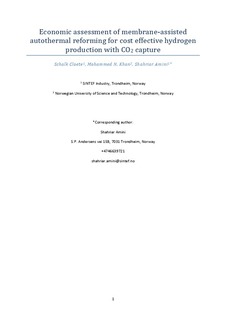| dc.contributor.author | Cloete, Schalk Willem Petrus | |
| dc.contributor.author | Khan, Mohammed Nazeer Ul Hasan | |
| dc.contributor.author | Amini, Shahriar | |
| dc.date.accessioned | 2019-09-24T11:17:53Z | |
| dc.date.available | 2019-09-24T11:17:53Z | |
| dc.date.created | 2019-04-10T20:19:46Z | |
| dc.date.issued | 2019 | |
| dc.identifier.citation | International Journal of Hydrogen Energy. 2019, 44 (7), 3492-3510. | nb_NO |
| dc.identifier.issn | 0360-3199 | |
| dc.identifier.uri | http://hdl.handle.net/11250/2618472 | |
| dc.description.abstract | A recent techno-economic study (Spallina et al., Energy Conversion and Management 120: p. 257–273) showed that the membrane assisted chemical looping reforming (MA-CLR) technology can produce H2 with integrated CO2 capture at costs below that of conventional steam methane reforming. A key technical challenge related to MA-CLR is the achievement of reliable solids circulation between the air and fuel reactors at large scale under the high (>50 bar) operating pressures required for optimal performance. This work therefore presents process modelling and economic assessments of a simplified alternative; membrane assisted autothermal reforming (MA-ATR), that inherently avoids this technical challenge. The novelty of MA-ATR lies in replacing the MA-CLR air reactor with an air separation unit (ASU), thus avoiding the need for oxygen carrier circulation. The economic assessment found that H2 production from MA-ATR is only 1.5% more expensive than MA-CLR in the base case. The calculated cost of hydrogen (compressed to 150 bar) in the base case was 1.55 €/kg with a natural gas price of €6/GJ and an electricity price of €60/MWh. Both concepts show continued performance improvements with an increase in reactor pressure and temperature, while an optimum cost is achieved at about 2 bar H2 permeate pressure. Sensitivities to other variables such as financing costs, membrane costs, fuel and electricity prices are similar between MA-ATR and MA-CLR. Natural gas prices represent the most important sensitivity, while the sensitivity to membrane costs is relatively small at high reactor pressures. MA-ATR therefore appears to be a promising alternative to achieve competitive H2 production with CO2 capture if technical challenges significantly delay scale-up and deployment of MA-CLR technology. The key technical demonstration required before further MA-ATR scale-up is membrane longevity under the high reactor pressures and temperatures required to minimize the cost of hydrogen. | nb_NO |
| dc.language.iso | eng | nb_NO |
| dc.publisher | Elsevier | nb_NO |
| dc.rights | Attribution-NonCommercial-NoDerivatives 4.0 Internasjonal | * |
| dc.rights.uri | http://creativecommons.org/licenses/by-nc-nd/4.0/deed.no | * |
| dc.title | Economic assessment of membrane-assisted autothermal reforming for cost effective hydrogen production with CO 2 capture | nb_NO |
| dc.type | Journal article | nb_NO |
| dc.type | Peer reviewed | nb_NO |
| dc.description.version | acceptedVersion | nb_NO |
| dc.source.pagenumber | 3492-3510 | nb_NO |
| dc.source.volume | 44 | nb_NO |
| dc.source.journal | International journal of hydrogen energy | nb_NO |
| dc.source.issue | 7 | nb_NO |
| dc.identifier.doi | 10.1016/j.ijhydene.2018.12.110 | |
| dc.identifier.cristin | 1691470 | |
| dc.description.localcode | © 2019. This is the authors’ accepted and refereed manuscript to the article. Locked until 9.1.2021 due to copyright restrictions. This manuscript version is made available under the CC-BY-NC-ND 4.0 license http://creativecommons.org/licenses/by-nc-nd/4.0/ | nb_NO |
| cristin.unitcode | 194,64,25,0 | |
| cristin.unitname | Institutt for energi- og prosessteknikk | |
| cristin.ispublished | true | |
| cristin.fulltext | postprint | |
| cristin.qualitycode | 2 | |

